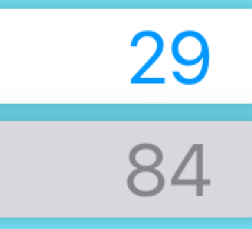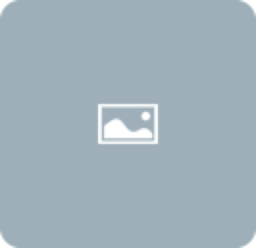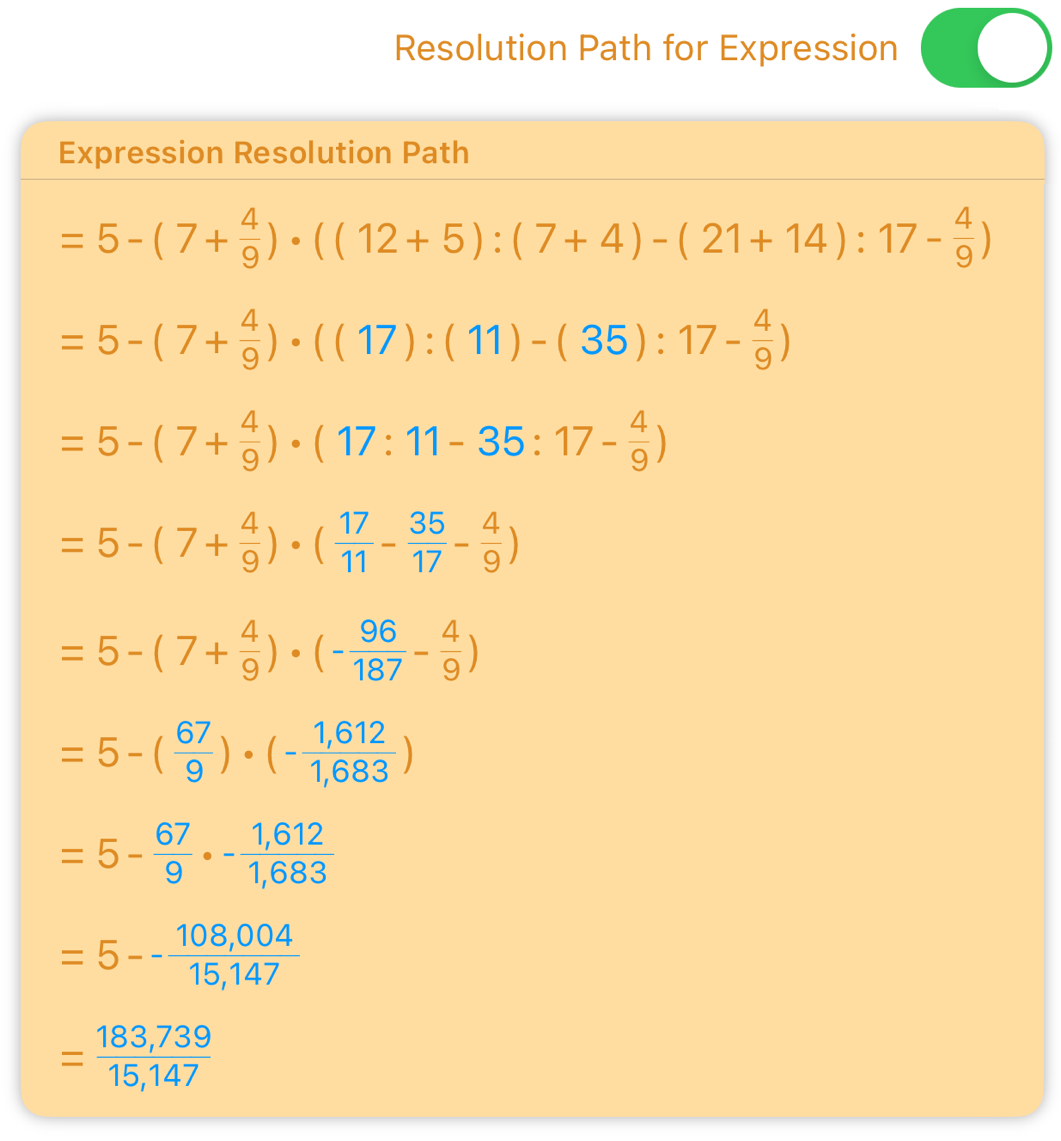
The focus of this guide is on using the FracEx Calc App.
A feature overview and a detailed description of the user interface are available on separate pages and should be read before reading this guide.
There you will find all the information about the general features and the elements of the user interface, including input and output in the FracEx Calc App.
This page refers to this information but does not describe it again.
The following is displayed at the top right with the respective icon and background colors if a section may only apply to one mode.

Relevant to Expressions-Mode

Relevant to Calculator-Mode
At its core, FracEx Calc consists of two calculation modules,

The Expressions mode provides an intuitive user interface for using these two modules, allowing convenient calculation of even complex arithmetic expressions.
In principle, the “normal user” always uses the expression mode and can subsequently skip the sections that relate exclusively to the calculator mode.

In addition to the expression mode, the calculator mode allows the experienced user of electronic calculators to use the fraction arithmetic functions of FracEx Calc appropriate to the electronic calculator.
With the help of the memory register, the calculation of complicated arithmetic expressions can also be achieved in this mode.
FracEx Calc is a special solution for
This makes the app particularly interesting
This makes FracEx Calc an excellent supplement to conventional calculation apps or calculators, which generally do not cover this area of application.
Fractions are always reduced immediately. Numbers can generally be entered as fractions, integers or floating point numbers. The input is basically converted into a fraction for further processing.
Arithmetic operations are always carried out on fractions, the result is again a fraction.
Numbers are always output as fractions, mixed fractions and floating point numbers.
Up to 5,000 digits can be displayed for a floating point number. If the floating point number consists of more digits, the last digits (up to 5 digits) can optionally be displayed.
Output of details for the floating point number is optional. This is the number of places before and after the decimal separator, the number of non-periodic and periodic places after the decimal point.
A representation of all the necessary details for input and output in the different number formats can be found on the user interface page.



Integer

Floating Point Number

Numerator
Denominator
Fraction

At first glance, it may seem surprising that arithmetic expressions are relevant for both modes. Regardless of the mode, solving calculation exercises always means resolution of arithmetic expressions. However, the way arithmetic expressions must be entered differs depending on the mode.

An arithmetic expression consists of
Arithmetic expressions with integers
5 + 3
5 + 3 * 7 - 5 : 2
Arithmetic expressions with floating point numbers
0.25 + 3.74
0.25 * -3.75 + 231.74538 : -5.56872 + 9.2
Arithmetic expressions with fractions
2
3
+
12
27
32
17
+
2
29
*
42
49
-
9
11
32 + 21
29 +13
-
424 - 9
11
32 * 21
29 *13
-
424 * 9
11
The entry of these two expressions will be explained later.
Arithmetic expressions with parentheses
2 : ( 3 + 12 ) : 27
0.25 * -( 3.75 + 231.74538 ) : ( -5.56872 + 9.2 )
(32 + 21) : (29 +13) - (424 - 9) : 11
32
17
2
29
42
49
9
11
(
+
)
*
(
-
)
( 2 *
(
32
17
+
2
29
)
- 3 *
(
42
49
-
9
11
) ) : 5
The examples listed provide the basis for creating far more complex arithmetic expressions, which can also be further combined and nested more deeply.
How to enter calculation expressions in FracEc Calc is explained below.
The default mode in FracEx Calc is Expressions mode. It allows you to conveniently use all of the app's functions through simple and intuitive use. Users who require comfortable and easy operation when calculating arithmetic expressions and/or fractions should only work in expression mode.
The Calculator mode can be ignored completely without any restrictions on the functionality of FracEx Calc. However, this mode has its right to exist due to the widespread use of electronic calculators and the associated experience of part of our user group. The calculator mode is aimed at experts in using electronic calculators or those who want to become one.
In expression mode, the calculation expression is entered exactly 1:1 as specified. The calculation is carried out according to the priority rules, i.e. in the priority order (1) solving partial expressions and then (2) dot calculation before (3) dash calculation.
Entering:
corresponds with 5 + 56 = 61






However, it should be noted that expressions cannot be entered within fractions, i.e. numerators and denominators are only numbers.
In the event that a exercise contains numerator and/or denominator expressions, these must be divided by each other as partial expressions (i.e. placed in parentheses).
An example of this follows below.
In calculator mode, the calculation takes place in the order in which the input is made.
This means that careful attention must be paid to compliance with the priority rules when entering data.
Entering:
Corresponds with ( 5 + 7 ) * 8 = 12 * 8 = 96, while a calculation of 5 + 7 * 8 according to the precedence rules leads to the result 5 + 56 = 61.
The expression mode and the calculator mode therefore calculate different results for the same input due to the fundamentally different treatment of priority rules.
Using the memory register, it is also possible to calculate more complex expressions in calculator mode.
Nevertheless, in complex calculations it may be necessary to adapt the order of entry to the precedence rules or, if necessary, to note down intermediate results and re-enter them.






This section describes how to use FracEx Calc for the various calculation operations.
While using the basic arithmetic operations of addition, subtraction, multiplication and division is intuitive, dealing with less obvious operations is also discussed.
2
3
+
12
27
=
10
9











(

)
In expression mode, the final input of [=] is not absolutely necessary. The results of expressions are continuously validated and for valid expressions the results are already output as you type.
=
10
9












In calculator mode, the final entry of [=] is mandatory.
2
3
12
27
-
=
2
9











(

)
=
2
9












2
3
12
27
*
=
8
27











(

)
=
8
27












2
3
12
27
:
=
3
2











(

)
=
3
2












All entries and results are immediately shortened in FracEx Calc.
All you have to do is enter a fraction and the shortened result is displayed.
27
81
=
1
3







(

)
=
1
3








This function can be used for both
Because the result is always output as a floating point number or integer, the conversion of fractions always takes place automatically.
0,75
=
3
4







(

)
=
3
4








21,75
=
=
87
4
87
4
= 21
= 21
3
4
3
4
= 21,75
= 21,75









(
)
=
=
87
4
87
4
= 21
= 21
3
4
3
4
= 21,75
= 21,75









Mixed fractions are improper fractions in mixed notation, specifying the integer part and the real fraction part.
Real fractions are fractions whose denominator is larger than their numerator.
There are various options for entering mixed fractions; the variant shown here is intended to show less experienced users in particular a safe and consistently applicable way to enter mixed fractions.
A mixed fraction is the sum of the integer part and the real fraction part:
7
3
4
= 7 +
3
4
= ( 7 +
3
4
)
When entering negative mixed fractions or subtraction (minus), there is a risk of accidental incorrect entry.
-2
1
3
= -2 -
1
3
= - ( 2 +
1
3
)
Basically, the recommendation for entering mixed fractions is to enter them as the sum of the integer part and the real fraction part and to negate the overall result if the values are negative.
7
3
4
=
31
4
= 7
3
4
= 7.75













31
4
3
4
= 7
= 7.75
=












(
)
-
7
3
4
= -
31
4
= - 7
3
4
= -7.75












(

)
= -
31
4
= - 7
3
4
= -7.75














The notation of fractions with expressions (or even further fractions) in the numerator and/or denominator represents a division of the expression in the numerator by the denominator.
For exercises with expressions (or fractions) in the numerator and/or denominator, these sub-expressions are specified as the dividend or divisor of a division operation (divide).
3 + 5
4 + 7
8
11
= ( 3 + 5 ) : ( 4 + 7 ) = 8 : 11 =
3 + 5
4 + 7
=
8
11














(

)
The sub-expressions must be placed in parentheses because of the priority rules (point calculation before line calculation)!
=
8
11
















3
5
-
2
3
4
7
+
1
6
= -
14
155




(




)














= -
14
155























Finally, we apply the methods presented so far to the calculation in a more complex expression - exclusively in expression mode.
5 - 7
4
9
*
(
12 + 5
7 + 4
-
21 + 14
17
-
12
27
)
=
183.739
15.147















































(

)
Video for entering this exercise:
In the expression mode there is the option to have FracEx Calc display the calculation of the arithmetic expression step by step.
In each line, the values resolved in the respective calculation step are highlighted in blue to make it easier to follow the calculation. More than just one value can be calculated per step.
This is the app’s calculation method. This is just one of many different possibilities.
Please be remembered again that in FracEx Calc every value is implicitly and automatically shortened.
For the recent example of a complex arithmetic expression

5 - 7
4
9
*
(
12 + 5
7 + 4
-
21 + 14
17
-
12
27
)

FracEx Calc supports the user with specific warning and error information.
While entering numbers, the status indicator provides information about the current entry.
In expression mode, the arithmetic expression status indicates the validity of the current input of the expression.
Errors can be corrected through various measures, namely:
When entering fractions, a warning appears if the denominator is 0. This is the case if a 0 has been specified as the denominator or no value has yet been entered for the denominator.
Warning: Denominator must not 0! Enter valid Denominator!
Fix problem:
FracEx Calc schaltet automatisch zur Eingabe des Nenners, dort kann dann eine gültige Zahl eingegeben werden.
When entering fractions, an error message occurs if the numerator or denominator is too large. This is the case from 19 digits onwards.
This error also occurs when a calculation leads to a result with a numerator or denominator that is too large (including in the subtotal).
Error: Calculation overflow as Numerator or Denominator are too big!
Fix problem:
Delete the last digit in the numerator or denominator. Alternatively, for calculation expressions, remove the last element of the expression and correct the input.
Or if necessary reset to the initial state.
The length of a period is (optionally) specified in the result output.
The calculation of the digits in the period is stopped when the length reaches 500,000. Instead of the period length, a corresponding message is output:
Too many decimal places! Determination stopped.
If division by zero occurs, a corresponding error is thrown.
Error: Division by zero!
Fix problem:
To eliminate the cause, the dividend - i.e. the number that is divided by - must be adjusted to a number other than 0.
Error: Expression is invalid!
Fix problem:
To resolve the cause, a valid calculation expression must be entered. To do this, you can either delete the last element in the calculation expression until the error is corrected. From there you can continue to enter the expression correctly.
Alternatively, a reset to the starting state can be carried out and the calculation expression can be completely re-entered.
Error: Number can't be extended!
Fix problem:
A calculation can only be made within the supported domain.
If this error occurs due to incorrect input, it can be corrected when entering arithmetic expressions by deleting the last element and correcting the input. Alternatively, a reset and new entry is possible.
Undefined Error!
Fix problem:
When entering arithmetic expressions, the error can be corrected by deleting the last element and correcting the input. Alternatively, a reset and a new entry is possible.
Notify us via the contact form on the home page.